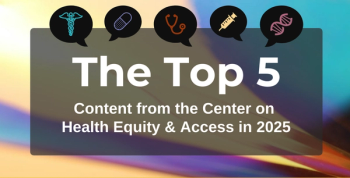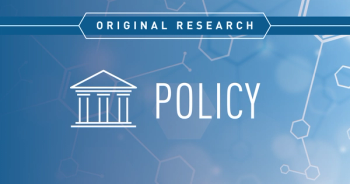
The American Journal of Managed Care
- Online Early
- Volume 31
- Issue Early
Assessing New York’s Health Care Disparities Using Health Plan Quality Data
Key Takeaways
Utilizing the Health Insurance Disparities Index for assessment, the authors found that New York’s Medicaid health maintenance organizations (HMOs) outperformed Medicaid HMOs nationally in addressing health care disparities from 2019 to 2023.
ABSTRACT
Objectives: To assess whether New York’s extensive use of waiver programs and financial incentives for quality provided to Medicaid managed care plans resulted in reduced health care disparities by using the newly developed Health Insurance Disparities Index (HeIDI) to compare the performance of commercial/private vs Medicaid plans in New York (and separately for New York’s Medicaid Health and Recovery Plan [HARP] plans for individuals with severe mental illness or substance use disorder) vs the nation as a whole.
Study Design: The HeIDI methodology utilizes public quality metrics reporting from the National Committee for Quality Assurance (NCQA) Healthcare Effectiveness Data and Information Set to produce an annual score for disparities comparing the performance of commercial/private health maintenance organizations (HMOs) nationally vs Medicaid HMOs nationally, and similarly for New York.
Methods: Using NCQA’s and New York’s e–Quality Assurance Reporting Requirements (eQARR) data sets for measurement years 2019-2023, performance was analyzed employing the HeIDI methodology. HeIDI scores were compared between national Medicaid plans and New York’s Medicaid mainstream plans and HARP plans.
Results: Between 2019 and 2023, New York’s Medicaid plans consistently outperformed national Medicaid plans by a factor of 2. New York’s HARP plans similarly outperformed the national mainstream Medicaid plans during the same time frame. This suggests that New York’s approach to managing Medicaid produces more equitable care between enrollees with different income levels compared with plans nationally.
Conclusions: Compared with other states, New York has made substantial progress in its Medicaid managed care programs. Future research questions include identifying specific New York initiatives or health plan characteristics that drive this superior performance.
Am J Manag Care. 2025;32(5):In Press
Takeaway Points
Using the newly developed Health Insurance Disparities Index, we found that New York’s Medicaid health maintenance organizations (HMOs) outperformed Medicaid HMOs nationally in closing the gap for health care disparities by enrollee income. Additionally, New York’s Medicaid Health and Recovery Plans for severely mentally ill Medicaid beneficiaries also outperformed mainstream Medicaid HMOs in other states. The following characteristics of New York’s approach for managing Medicaid managed care could explain its strong performance:
- value-based payment and quality incentive programs;
- waiver programs;
- eligibility and benefit design;
- integration of physical health services with behavioral health; and
- health plan characteristics.
The impact of socioeconomic status, race, ethnicity, education, and place of residence on health care disparities in the US has been well described,1-3 with poverty and socioeconomic status representing major social determinants of health (SDOH) driving these disparities.4 An individual’s type of health insurance (ie, commercial/private vs Medicaid) is a reflection of these 2 drivers and can serve as an appropriate basis for assessing health care delivery and its effectiveness in addressing and eliminating health care disparities. Almost 90% of enrollees in Medicaid health maintenance organizations (HMOs) have a household income below 400% of the federal poverty level, and nearly 60% of commercial/private HMO enrollees have a household income above that threshold.5 Comparing the quality of medical care delivered to Medicaid HMO enrollees vs commercial/private HMO enrollees is an important and practical way to measure health care disparities between income groups, especially when individual-level data on income are not readily available. This study examines whether state policies integrating physical and behavioral health, promoting access to quality health care, widely employing waiver programs (eg, section 1115 waivers), and providing strong financial incentives for Medicaid HMOs to improve quality have reduced the gap in the quality of care received by individuals with high vs low incomes overall and separately for individuals with severe mental illness or substance use disorder. Although Medicaid enrollees likely receive lower-quality care on average, this study is the first to our knowledge to examine how much lower the care quality is and whether any gaps changed over time in a state (New York) that has enacted policies to improve the quality of care delivered to individuals with low incomes.
Although CMS manages/regulates Medicare, health insurance programs are generally regulated by individual states.6 As prominent stakeholders, states can address health care disparities by regulating Medicaid insurance offerings and full-risk commercial/private plans not subject to the Employee Retirement Income Security Act of 1974. Consequently, states may pursue Medicaid federal waiver programs that may narrow disparities. This article applies the Health Insurance Disparities Index (HeIDI) to New York as a case study to explore whether substantial Medicaid funding and policies expanding access to quality health care have decreased health care disparities. As previously reported,7 HeIDI utilizes the National Committee for Quality Assurance (NCQA) Healthcare Effectiveness Data and Information Set (HEDIS) quality of care delivery measures.8 Because NCQA’s website provides national averages for numerous HEDIS measures for both commercial and Medicaid programs without charge, these results represent an inexpensive and convenient way to use the HeIDI. Various nationally recognized entities have endorsed the measures within the HeIDI measures portfolio, includingthe CMS Core Sets of Health Care Quality Measures for Medicaid,9 NCQA-required HEDIS measures for health plan accreditation and ratings programs for commercial/private and Medicaid plans,10,11 the National Quality Forum (NQF) and the Partnership for Quality Measurement (PQM) with their Disparities-Sensitive Measures Set (the original measures set was ceded to PQM after NQF’s contract with CMS was assigned to PQM),12,13 and the Core Quality Measure Collaborative (CQMC) Consensus Core Sets.14 Additionally, states use these measures for value-based payment (VBP) programs and/or public reporting for Medicaid plans.7
HeIDI’s HEDIS measures (24 physical medicine–related and 15 behavioral health–related measures) are validated, publicly available, and reported by commercial/private plans and Medicaid managed care plans for accreditation and health plan ranking purposes. HeIDI’s methodological approach has demonstrated a gradual worsening of disparities nationally between individuals with Medicaid vs commercial/private insurance from 2017 to 2022.7
Aligning with NCQA’s health plan ratings methodology,15 HeIDI can be adjusted to remove any measures that any state does not publicly report or that require plan reporting. Furthermore, HeIDI affords modifications for making comparisons for specialized Medicaid plans restricted to particular health conditions (eg, severe mental illness) under section 1115 Medicaid waivers.
New York is an interesting state for analyzing disparities. Nearly 72 million individuals are enrolled nationally in 42 states that use Medicaid managed care,16,17 and New York ranks second in Medicaid managed care enrollees (approximately 5,634,000), representing 75% of all Medicaid recipients in New York. Of the Medicaid managed care enrollees in New York, nearly 177,000 individuals are enrolled in the state’s separate 1115 waiver program for Health and Recovery Plan (HARP) plans providing Medicaid coverage and specialized services for adults with serious mental illness (SMI) and/or severe substance use disorder (SUD).18
Although 26 states represent more than 90% of Medicaid enrollees nationally, few of them provide readily accessible, free quality performance reporting of their Medicaid managed care plans. New York’s e–Quality Assurance Reporting Requirements (eQARR) website has publicly provided these data for more than a decade.19 New York has high Medicaid spending per enrollee,20 providing strong financial incentives for Medicaid managed care plans to improve quality by linking reimbursement to health plan quality performance,21 publicizing health plan ratings in its consumer guides22 to influence enrollees’ plan choices, and favoring high-quality plans for auto-assigning individuals without a selected plan.23 New York has implemented numerous 1115 waiver programs such as its $6.4 billion Delivery System Reform Incentive Payment (DSRIP) program to integrate behavioral and physical health and expanded VBP programs,24 HARP plans for those with SMI/SUD,18 a Health Home program facilitating enhanced care delivery to its Medicaid population,25 and the 2024 $7.5 billion New York Health Equity Reform 1115 waiver program.26
This study was exempt from review by an institutional review board because it utilizes publicly available aggregated data and is being used for quality improvement purposes.
Methodological Approach
We used the HeIDI methodology and measures reported by both NCQA and New York to calculate an aggregate quality-of-care measure for commercial/private plans and Medicaid plans separately, nationally, and for New York only for measurement years 2019-2023 (a reporting year follows a calendar year). Insurance products for this analysis were commercial/private and Medicaid managed care organizations enrolling individuals 65 years and younger, including employer-sponsored plans but excluding exchange/marketplace plans (these are accredited and rated as separate plans), ensuring a uniform age range of enrollees across plan types.
Consistent with NCQA’s plan ratings methodology,15 when a given HeIDI metric is not required for reporting or not reported in New York, that measure was excluded from the HeIDI calculation for the analysis for both the national Medicaid and commercial/private insurance product lines. For the analysis between the mainstream national Medicaid and New York Medicaid plans, we removed 3 physical medicine–related and 2 behavioral health–related measures not publicly reported by New York from the HeIDI measure portfolio (with their codes in parentheses): appropriate treatment for upper respiratory infection (URI); avoidance of antibiotic treatment for acute bronchitis/bronchiolitis (AAB); plan all-cause readmissions (PCR); initiation of substance use disorder treatment–total (IET); and engagement of substance use disorder treatment–total (also IET).21 Because the excluded measures of URI, AAB, and both IETs are currently reported by states that collectively represent less than 50% of Medicaid enrollees nationally,7 New York should not be an outlier for not publicizing these measures. Additionally, because NCQA stopped reporting the PCR measure on its website and results from its Quality Compass (QC) HEDIS database27 require comparing observed to expected rates based on enrollees’ health conditions, not including these 5 measures likely does not significantly impact the representativeness of our New York analysis.
Because CMS does not specify how a state defines health plan quality, each state reports its own Medicaid quality improvement strategy every 3 years. Because 37 states, representing 91% of Medicaid enrollees, require their Medicaid health plans to achieve NCQA health plan accreditation, Medicaid plans in these states must measure and report on all NCQA-required HEDIS measures in the HeIDI (covering 31 of the 34 measures publicly reported by New York and thus included in the HeIDI reported in this article). Because 38 states, representing 91% of commercial/private enrollees, require their commercial/private health plans to report HEDIS quality measures, these are incorporated in the national HeIDI measures analysis.28 Hence, the HeIDI provides a realistic, accessible, workable platform for assessing the status of health care disparities and is also largely representative of care delivered nationally.
Because New York HARP plans solely enroll adults, HeIDI pediatric measures were likewise removed from that particular analysis. The HeIDI measures used in HARP analyses comparing national, New York mainstream, and HARP Medicaid plans consisted of 14 physical medicine–related and 9 behavioral health–related measures. Table 117,18,21 lists the specific measures for the standard HeIDI portfolio of measures, specific measures utilized for the New York Medicaid mainstream plan analyses and HARP analyses,21 and each measure’s corresponding weight.
HeIDI compares the performance for each selected measure between commercial/private HMOs and Medicaid HMOs using the NCQA-reported national average for each product line,7 where higher values for measures indicate higher-quality care. If the performance difference between the plan types for a measure favors commercial/private plans over Medicaid plans, that difference indicates a disparity. In keeping with the NCQA’s weighting methodology, HeIDI assigns outcomes-based measures a relative weight of 3 (eg, controlling high blood pressure) and usually assigns process-based measures (eg, breast cancer screening) a relative weight of 1 unless the NCQA believes a process measure is particularly important from a health perspective (eg, adolescent and childhood immunizations measures are assigned a weight of 3 even though they are process-based measures).15 HeIDI offers no extra credit for any measure where the Medicaid product outperforms the commercial product; thus, the disparity is set to 0 rather than a negative number.
In computing a given year’s HeIDI score, the differences for each measure’s performance are weighted and then summed providing a difference (gap) numerator value. This numerator is then divided by the denominator of the weighted sum of the commercial/private product’s performance rates for all measures. The HeIDI score reflects the percentage-point difference in the quality of care received by Medicaid enrollees relative to commercial/private enrollees. Table 2 provides the HeIDI calculation formula.
The eAppendix (
As an indirect measure of disparities, the HeIDI compares the average quality of care received by individuals with relatively high incomes who tend to be enrolled in commercial/private health plans vs the average quality of care received by individuals with relatively low incomes likely enrolled in Medicaid. A direct measure of disparities requires observing both the income level of and quality of health care received by each enrollee, which is not currently available in most claims data sets. A perfect HeIDI score of 0 would indicate that Medicaid enrollees receive the same level of health care quality, on average, as commercial/private enrollees. Consequently, enrollees with relatively low incomes in each plan type may be receiving worse care than enrollees with relatively high incomes in the same plan type. Scores greater than 0 indicate that commercial/private enrollees receive higher-quality care in aggregate relative to individuals in Medicaid managed care.
To explore another application of HeIDI, we performed a secondary intrastate analysis calculating HeIDI scores for the national Medicaid plans and New York plans by substituting the New York commercial/private health plans’ averages with HeIDI measure scores in place of the national commercial/private health plans’ averages.
RESULTS
Figure 118,19,27 displays HeIDI indices for New York Medicaid plans and all Medicaid plans nationally for 2019 through 2023, where the national averages for private/commercial plans establish the standard in each of the 2 calculations and the HeIDI indices are statistically greater than 0. In 2019, New York Medicaid plans had a HeIDI score almost 6 percentage points lower than national Medicaid plans, indicating that New York plans provided more equitable care than the latter because the quality of care received by New York Medicaid enrollees was closer to the national private/commercial standard than Medicaid enrollees in the other states. Despite the impact of the COVID-19 pandemic, New York Medicaid plans consistently demonstrated a 4.8- to 5.9-point advantage for measurement years 2019-2023.
In the HARP HeIDI analysis using the HARP-specific measures (Figure 28,19,27), New York mainstream Medicaid plans maintained a nearly 2-fold advantage over the national Medicaid managed care plans and New York HARP programs demonstrated a superior (ie, more equitable) performance vs the national mainstream Medicaid plans. New York HARP plans consistently outperformed the national Medicaid plans by at least 1 point on an annual basis, although the differences were not statistically significant for years 2021-2023. COVID-19 blunted that advantage from nearly 2 points in 2019 to 1.2 points in 2023. This is notable because HARP plan enrollees constitute some of the sickest and most greatly disadvantaged individuals on Medicaid due to their SMI/SUD conditions and substantial SDOH challenges.
The secondary New York intrastate HeIDI analysis (Figure 38,19,27) compares the New York Medicaid plans’ HeIDI performance derived from the national commercial/private plans’ averages (Figure 1) vs the New York Medicaid plans’ HeIDI performance when replacing the national commercial/private plans’ averages data with the New York commercial/private health plans’ averages data to establish the quality standard. This adjusts HeIDI to incorporate state-specific market characteristics, such as provider quality, potentially impacting the quality of health care provided to both private/commercial and Medicaid enrollees in New York.
This secondary New York intrastate HeIDI analysis demonstrates a worse HeIDI performance for the New York Medicaid plans when using the New York commercial/private plans’ averages compared with the previously noted New York Medicaid plans’ performance using the national commercial/private plans’ averages. Because the same metrics were used in the HeIDI calculations, one can infer that the New York commercial/private plans typically perform at a higher level in these 34 selected measures than their national commercial/private counterparts. One can logically assume, given the national Medicaid plans’ comparatively worse performance vs the New York Medicaid plans (Figure 1), that HeIDI scores for the national Medicaid plans using the New York commercial/private plans instead of the national commercial/private plans would be far worse than those of their New York Medicaid peers. Because CIs are wide when using New York commercial/private data given that there are fewer such New York plans than national plans, the HeIDI indices (Figure 3) are not statistically different using New York vs national data as reference points for years 2021-2023.
DISCUSSION
One driver for HeIDI scores worsening after 2020 is the likely negative impact of COVID-19, including the reduction in the health care workforce and resulting decrease in access to care, disproportionately impacting patients with lower incomes than higher incomes.29 CMS and others have raised concerns about the potential widening of health inequities from the greater adoption of virtual and telemedicine services in response to the pandemic because low-income, working poor, and rural populations have worse access to these services than individuals from higher socioeconomic backgrounds.30-33 Interestingly, New York Medicaid plans’ HeIDI scores retained their nearly 2-fold advantage over the national Medicaid plans’ scores during the 5 measurement years. Because New York had enacted policies providing strong financial incentives and waiver programs for Medicaid plans to improve quality, we infer, although without certainty, that several important reasons for the state’s superior performance would include the following:
- New York’s VBP initiatives focus on quality-of-care improvements achieved via collaboration with managed care organizations and providers through clinical advisory groups to implement VBP programs and select meaningful quality metrics in support of these efforts.21
- Since implementing the Health Home program, New York has witnessed marked performance improvements for numerous HEDIS processes-of-care measures for Health Home enrollees and at least a 25% reduction in inpatient admissions and emergency department visits for this high-risk population.25
- Implementation of the DSRIP program restructured the health care delivery system in New York by reinvesting in its Medicaid program.24
- The New York Health Equity Reform 1115 waiver program established social care networks to deliver health-related social needs services.26
US health care disparities are multifaceted in nature, with underlying causes that include but are not limited to widespread poverty, racism and its inherent presence in our health care system, types of health care coverage and access to it, health plan operations, and health care delivery system design/operations including cultural competency, practitioner training, and understanding of public health issues. Without simple or quick solutions, various stakeholders, including health systems researchers and the states regulating/managing Medicaid, should examine different aspects of their health care environment to identify, formulate, and implement interventions to potentially improve their sector of the system.
To this end, HeIDI can serve as a useful platform to further examine and understand how high-performing states such as New York have succeeded more than others in narrowing these health care disparity gaps through their Medicaid managed care programs. Because the insurance products being compared (commercial/private vs Medicaid) reflect differences in socioeconomic status, a given state’s HeIDI performance might motivate it to pursue SDOH-based waivers for its Medicaid program. States should study the impact of enrollment eligibility, benefit design, federal waiver program utilization, behavioral health services integration within health plans, characteristics of high-performing health plans, VBP programs, and other quality improvement–based reimbursement approaches. If data are not readily reported by a state agency, one may obtain individual health plan and/or state performance reporting by individual HEDIS measures through a licensed subscription to the NCQA’s QC.27
Limitations
Although the states, NCQA, CMS, PQM, CQMC, and other national entities34 may affect HeIDI measures by implementing measurement updates, such changes in measures/specifications have national impacts across all health plan product lines, thereby minimizing their effect on comparisons. Should any measure be retired, other measures meeting inclusion criteria will replace them without significantly impacting the tool’s integrity. One could infer that New York mainstream Medicaid plans’ superior performance was a result of the enrollment of the 170,000-plus individuals with SMI/SUD into the separate HARP program, excluding them from the mainstream plans. However, with New York’s Medicaid managed care enrollees contributing nearly 8% of the performance results for the national Medicaid plans and with HARP plans performing better than the national mainstream Medicaid plans, such a concern is probably unsubstantiated.
To minimize subjectivity and promote accessibility, we only included quality measures in HeIDI if they were also included in HEDIS. There may be other indicators not included in HEDIS, however, such as whether an enrollee lives in a household whose income is below the federal poverty level, that may be more predictive of receiving high-quality care than some of the HEDIS measures. Any concerns about excluding several quality care metrics from the standard HeIDI measures portfolio for the New York analyses should be allayed because they are small in number and the remaining measures are national key core measures of processes and outcomes of care.
CONCLUSIONS
Based on the HeIDI index calculations, New York’s Medicaid managed care programs have continually demonstrated superior performance in narrowing health care disparities compared with Medicaid plans nationally. These findings should stimulate health systems researchers and other states to analyze and identify what characteristics reside in New York’s administration of Medicaid managed care.
Acknowledgments
The primary source for data contained in this publication is the NCQA’s publicly accessible web page, HEDIS Measures and Technical Resources, for 2019 though 2023. Any data display, analysis, interpretation, or conclusion based on these data is solely that of the authors, and the NCQA holds no responsibility for any such display, analysis, interpretation, or conclusion. Quality Compass is a registered trademark of NCQA. HEDIS is a registered trademark of NCQA. The sources for New York state plan performance data contained in this publication are the NCQA and the New York State Department of Health’s public and consumer-accessible “eQARR—An Online Report on Quality Performance Results for Health Plans in New York State.” Any data display, analysis, interpretation, or conclusion based on these data is solely that of the authors, and New York State Department of Health holds no responsibility for any such display, analysis, interpretation, or conclusion.
Because NCQA prohibits the public display of any entity’s specific HEDIS measurement results obtained from Quality Compass, the actual detailed calculations are unavailable to the readers of this paper. Consequently, the authors provide the summarized derived HeIDI results in Figures 1, 2, and 3.
Author Affiliations: Sloan Program in Health Administration, Cornell University Brooks School of Public Policy (JAS, HP, SN), Ithaca, NY; Veralon Partners Inc (SS), Bala Cynwyd, PA; Department of Economics, Cornell University (HP, SN), Ithaca, NY.
Source of Funding: None.
Author Disclosures: The authors report no relationship or financial interest with any entity that would pose a conflict of interest with the subject matter of this article.
Authorship Information: Concept and design (JAS, SN); acquisition of data (JAS, HP, SN); analysis and interpretation of data (JAS, HP, SS, SN); drafting of the manuscript (JAS, SS); critical revision of the manuscript for important intellectual content (JAS, SS, SN); statistical analysis (HP); and administrative, technical, or logistic support (JAS, HP).
Address Correspondence to: Joseph A. Stankaitis, MD, MPH, Cornell University Brooks School of Public Policy, 24 Hiram Way, Honeoye Falls, NY 14472. Email: jas2242@cornell.edu.
REFERENCES
1. Institute of Medicine. Crossing the Quality Chasm: A New Health System for the Twenty-first Century. The National Academies Press; 2001.
2. Institute of Medicine. Unequal Treatment: Confronting Racial and Ethnic Disparities in Health Care. The National Academies Press; 2003.
3. 2023 National Healthcare Quality and Disparities Report. Agency for Healthcare Research and Quality; December 2023. Accessed September 15, 2025.
4. National Academies of Sciences, Engineering, and Medicine. Communities in Action: Pathways to Health Equity. The National Academies Press; 2017.
5. Health insurance coverage of the total population: timeframe: 2023. KFF. Accessed September 15, 2025.
6. Pestaina K, Wallace R, Long M. What are the different types of private health plans? In: The Regulation of Private Health Insurance. KFF; May 28, 2024. Accessed September 15, 2025.
7. Stankaitis JA, Singh S, Nicholson S. Assessing health care disparities using a health plan quality measures index. Am J Manag Care. 2025;31(9):468-475. doi:10.37765/ajmc.2025.89701
8. HEDIS measures and technical resources. National Committee for Quality Assurance. Accessed September 15, 2025.
9. CMS measures inventory. Updated September 10, 2024. Accessed September 15, 2025.
10. 2025 health plan ratings required HEDIS, CAHPS and HOS measures. National Committee for Quality Assurance. Accessed September 15, 2025.
11. Evaluating Medicaid’s Use of Quality Measurement to Achieve Equity Goals. National Committee for Quality Assurance; December 2021. Accessed September 15, 2025.
12. Knowledge Library. National Quality Forum. Accessed September 15, 2025.
13. Partnership for Quality Measurement. Accessed September 15, 2025.
14. CQMC Implementation Guide. Core Quality Measures Collaborative; September 8, 2021. Accessed September 15, 2025.
15. 2025 Health Plan Ratings Methodology. National Committee for Quality Assurance; 2024. Accessed September 15, 2025.
16. Hinton E, Raphael J. 10 things to know about Medicaid managed care. KFF. February 27, 2025. Accessed September 15, 2025.
17. Total Medicaid MCO enrollment: timeframe: 2022. KFF. Accessed September 15, 2025.
18. Final Report on Managed Care Organization Services. New York State Department of Health; October 2023. Accessed September 15, 2025.
19. eQARR - an online report on quality performance results for health plans in New York state. New York State Department of Health. Updated March 2025. Accessed September 15, 2025.
20. Medicaid & CHIP. KFF. Accessed September 15, 2025.
21. 2019 value based payment reporting requirements. New York State Department of Health. Updated December 14, 2018. Accessed September 15, 2025.
22. Managed care regional consumer guides. New York State Department of Health. Updated November 2024. Accessed September 15, 2025.
23. 2021 Quality Incentive Report. New York State Department of Health. Updated September 2023. Accessed September 15, 2025.
24. Delivery System Reform Incentive Payment (DSRIP) program. New York State Department of Health. Updated March 2025. Accessed September 15, 2025.
25. Executive summary based on NYSDOH 2021-2022 Health Home for adults data. NY Health Home Coalition. Updated February 12, 2024. Accessed September 15, 2025.
26. New York Health Equity Reform (NYHER) 1115 waiver program: overview of social care networks (SCNs). New York State Department of Health. March 2025. Accessed September 15, 2025.
27. Quality Compass. National Committee for Quality Assurance. Accessed September 15, 2025.
28. States using NCQA programs. National Committee for Quality Assurance. Accessed September 15, 2025.
29. Impact of the COVID-19 pandemic on the hospital and outpatient clinician workforce: challenges and policy responses. Office of the Assistant Secretary for Planning and Evaluation. May 3, 2022. Accessed September 15, 2025.
30. Veinot TC, Mitchell H, Ancker JS. Good intentions are not enough: how informatics intervention can worsen inequality. J Am Med Inform Assoc. 2018;25(8):1080-1088. Accessed September 15, 2025. doi:10.1093/jamia/ocy052
31. Nouri S, Khoong EC, Lyles CR, Karliner L. Addressing equity in telemedicine for chronic disease management during the COVID-19 pandemic. NEJM Catalyst. May 4, 2020. Accessed September 15, 2025.
32. Price JC, Simpson DC. Telemedicine and health disparities. Clin Liv Dis (Hoboken). 2022;19(4):144-147. Accessed September 15, 2025. doi:10.1002/cld.1171
33. CMS Framework for Health Equity 2022-2032. CMS Office of Minority Health; April 2022. Accessed September 15, 2025.
34. HEDIS MY 2023 measures and descriptions. National Committee for Quality Assurance. Accessed September 15, 2025.
Articles in this issue
Newsletter
Stay ahead of policy, cost, and value—subscribe to AJMC for expert insights at the intersection of clinical care and health economics.








































